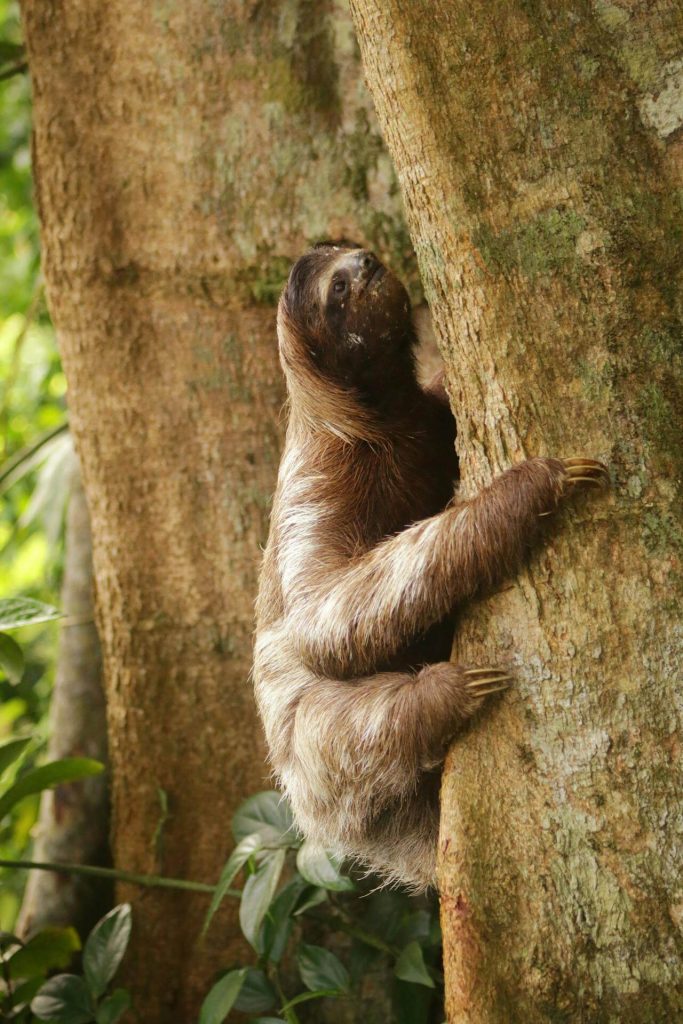Sloths and where to find them in Bolivia
♥ Sloths, those cute, friendly- and funny looking animals. Would you like to know some cool facts about them and where to find sloths in Bolivia?
Sloths are the slowest mammals on the planet (at top speed – as response to danger- they move at approximately 2,4 km per hour/1,5 miles per hour), but the fact that they are slow does not mean they are boring, all the oposite, they are pretty amazing!

Sloths are approximately 3 times stronger than the average human being when it comes to grip strength. They have 52 muscles in one arms! Sloths spend their lifes hanging from trees. Their limbs are adapted for suspending the body rather than supporting it. They move at a languid, sluggish pace through the trees and on the ground they are able only to drag themselves along with their claws.
They are not lazy but energy savers. Sloths are all about saving energy. They have very, very slow movements, but being slow is far from being lazy. Being slow is the sloth’s incredibly successful strategy for survival: sloths have survived on this planet for almost 64 million years!
With their slow metabolic rate they save a lot of energy! It takes a sloth 28 days to digest one leaf! Sloths use 90% less energy than the average animal. Talking about low energy use? Sloths have the lowest body temperature of all mammals in the world, it can drop to 30 degree Celsius.
Sloths in the wild only sleep for 8 – 10 hours per day. That sloths sleep all day long is a myth giving them this bad reputation.
Another myth-busting? The leaves sloths eat do not contain psychoactive substances which makes them slow or stoned.

Sloths are great swimmers. Although they prefer to live in trees, they are great swimmers! Their strong arms are made for holding onto branches, but are also well-suited for swimming. They can swim three times faster than they can walk on land. Their enormous stomach full of gas from digesting leaves acts as a giant flotation device. Swimming is an activity they seem to enjoy, the animals have been known to drop from the branches they’re clinging to into rivers below to take a swim.
Pooping is life-or-death for sloths. Sloths are creatures of habit. They poop only once a week and usually in the same spot. Sloths spend most of their time in treetops, females even give birth while hanging from tree branches. Their slow metabolism means they can go for long stretches in between. They have to climb down to the forest floor to do so when they are more vulnerable to predators. No wonder they hold it.
Sloth fur is home to a whole mobile ecosystem. A community of tiny animals burrow into a sloth’s hair to eat delicious algae that often grows there. Hundreds of moths, beetles, cockroaches, and worms can reportedly be found on some sloths. A single sloth can host up to 950 moths and beetles within its fur. Sloths’ coloration makes them difficult to spot, the algae give the animals a greenish tinge, the perfect camouflage, especially during the rainy season.
Sloths are color blind. They also don’t see very well in dim light and are completely blind in bright daylight. They do have an excellent sense of smell.
Sloths can see behind their backs. They really turn their heads almost all the way around! Thanks to an extra vertebrae in their spine which give them more neck flexibility, sloths can turn their heads up to 270 degrees in either direction.
Where to find sloths in the wild?
Sloths live throughout Central and South America. They are known in Spanish as perezosos or pericos.
Sloths in Bolivia: The lowland tropical forests of Bolivia are home to sloths, they are very common even in urban areas. Are you planning to visit Trinidad? You can spot them in the trees of the plazas in town.
When you are Santa Cruz we recommend to visit the Jardín Botánico (Botanical garden: Carretera a Cotoca, Km 8 1/2, Santa Cruz de la Sierra, Bolivia) where with a bit of luck and patience you will have the real possibility of seeing them! You can easily spend half day there. At the Botanical gardens you will also be able to spot other wildlife such as monkeys, caimans, turtles, toucans and other birds. You can also find sloths in the small town of Cotoca where you can spot them in the trees of the town plaza, as well as in Plaza de El Torno on the route to Samaipata. Tip: Visit Cotoca early in the morning, it’s not only cooler but you can also enjoy a delicious breakfast at the market. After that just choose a bench in the plaza, relax among the palm trees and other native plants and trees and enjoy the easy going life. Remember that a sloth-like pace sometimes make spotting cool things possible 😉
Important to consider: A cute pick-me-up? ♥ Yes, it is tempting to hold these little cute creatures, they are very easy-going, but some studies suggest that this contact might be stressful for sloths. In the wild, they are solitary and try not to draw attention in order to avoid predators. So unless you are trying to protect them or helping them back to a tree please refrain from petting them. No hands-on contact with sloths.
Spotting sloths is pretty cool, we can take you to these places during our city tour. Do you need more inspiration about what to do in Santa Cruz? Check also our list of 30+ things to do in Santa Cruz, Bolivia.
Read more about sloths: SlothOpedia.


